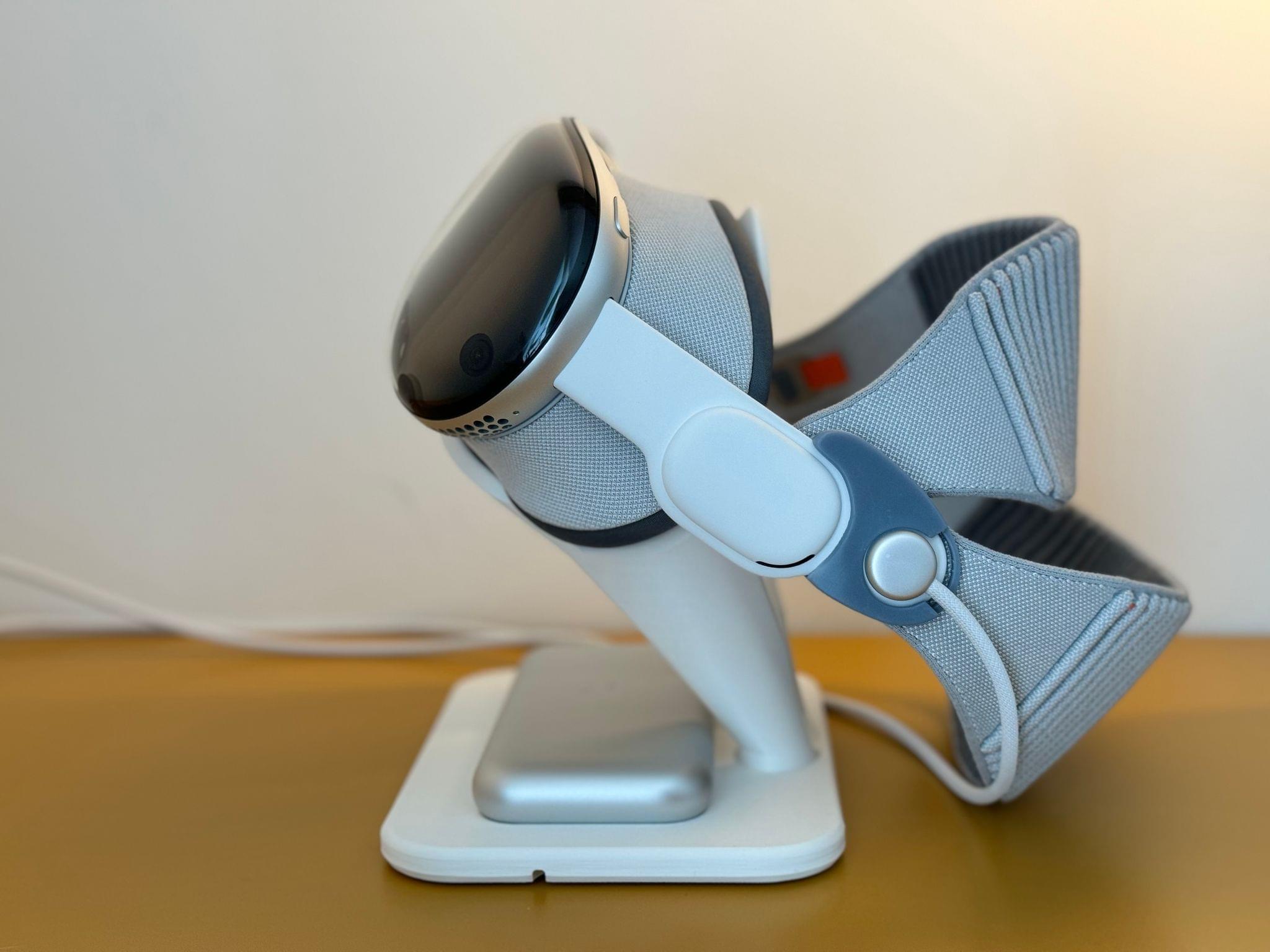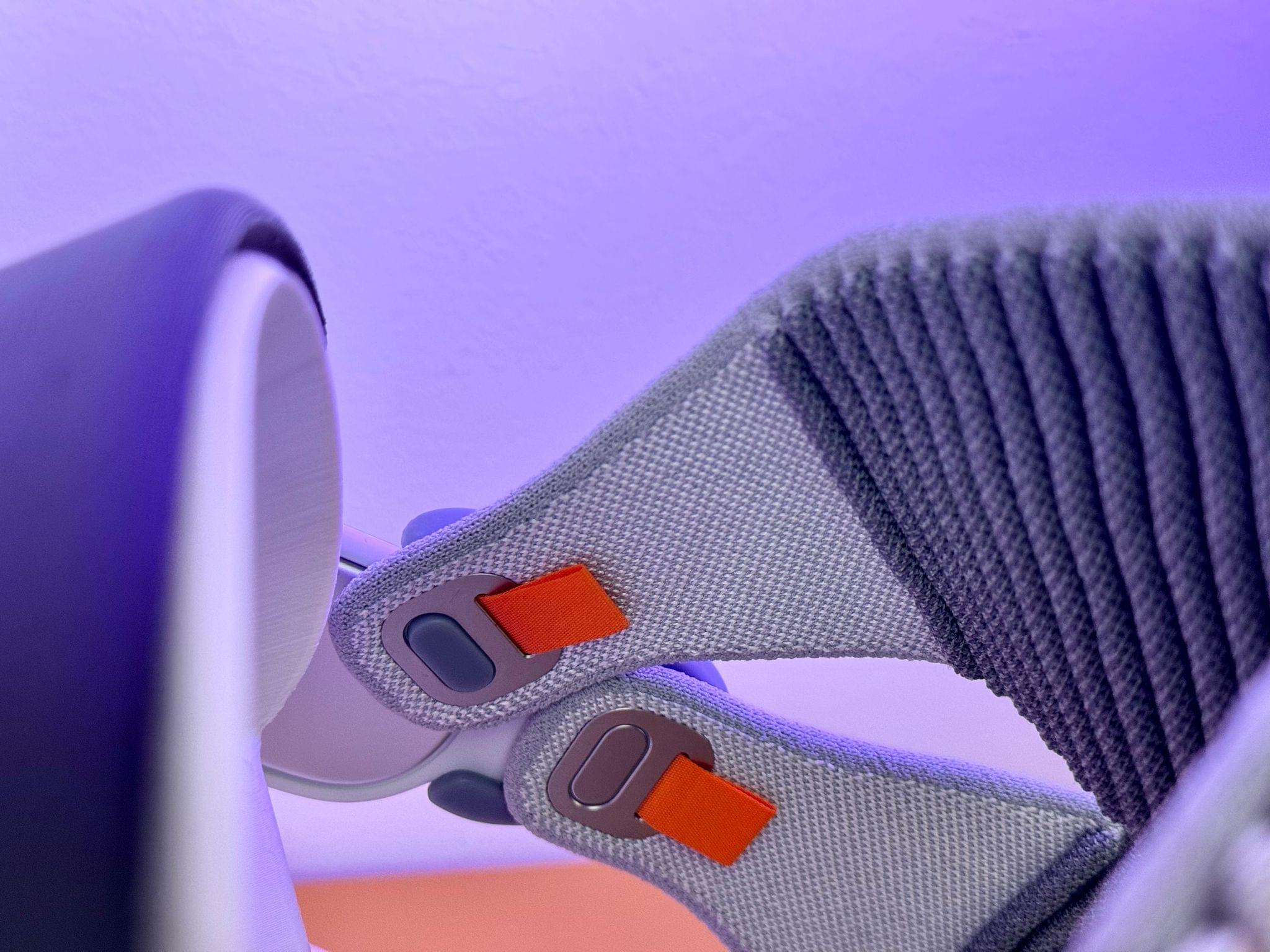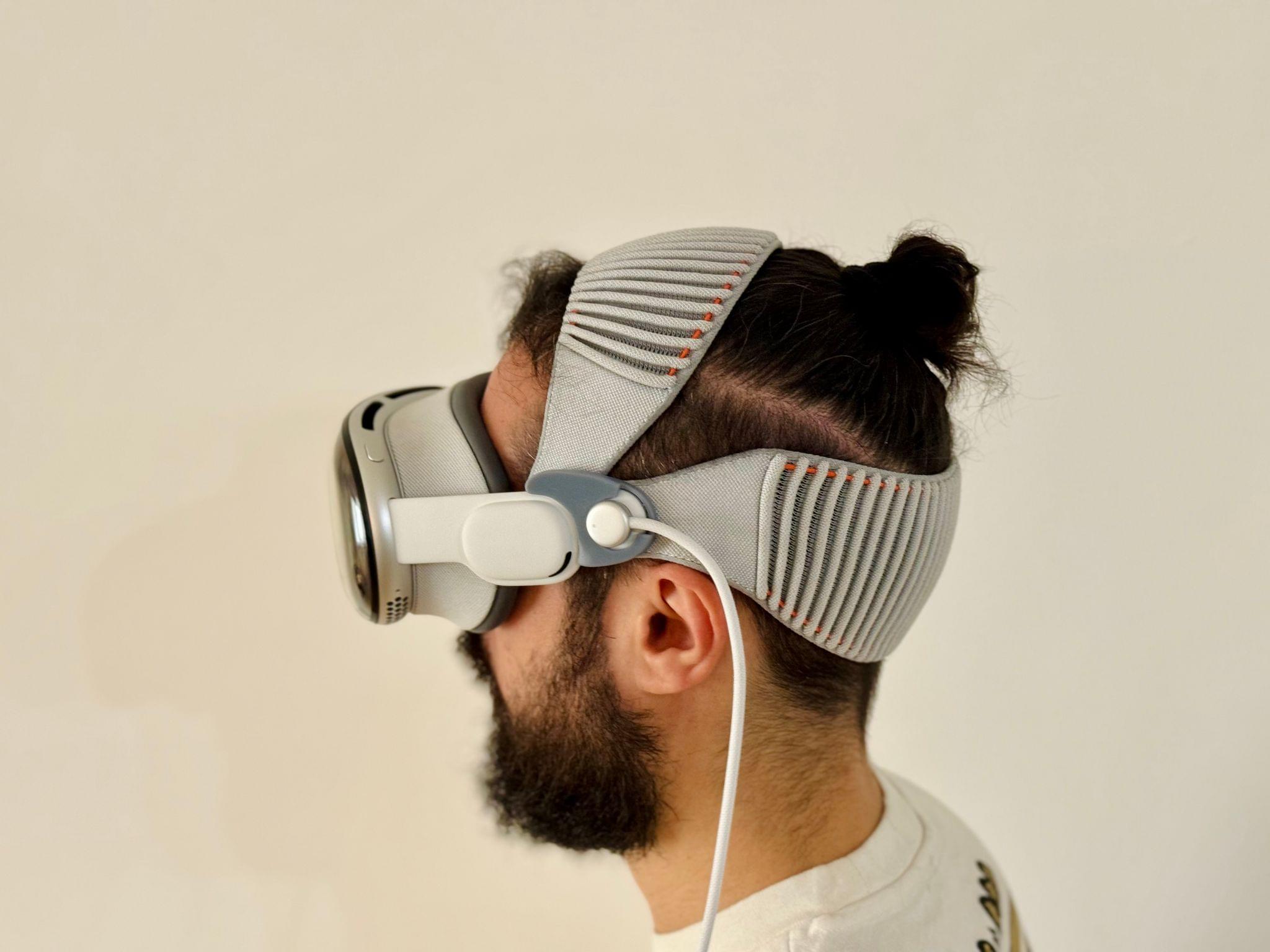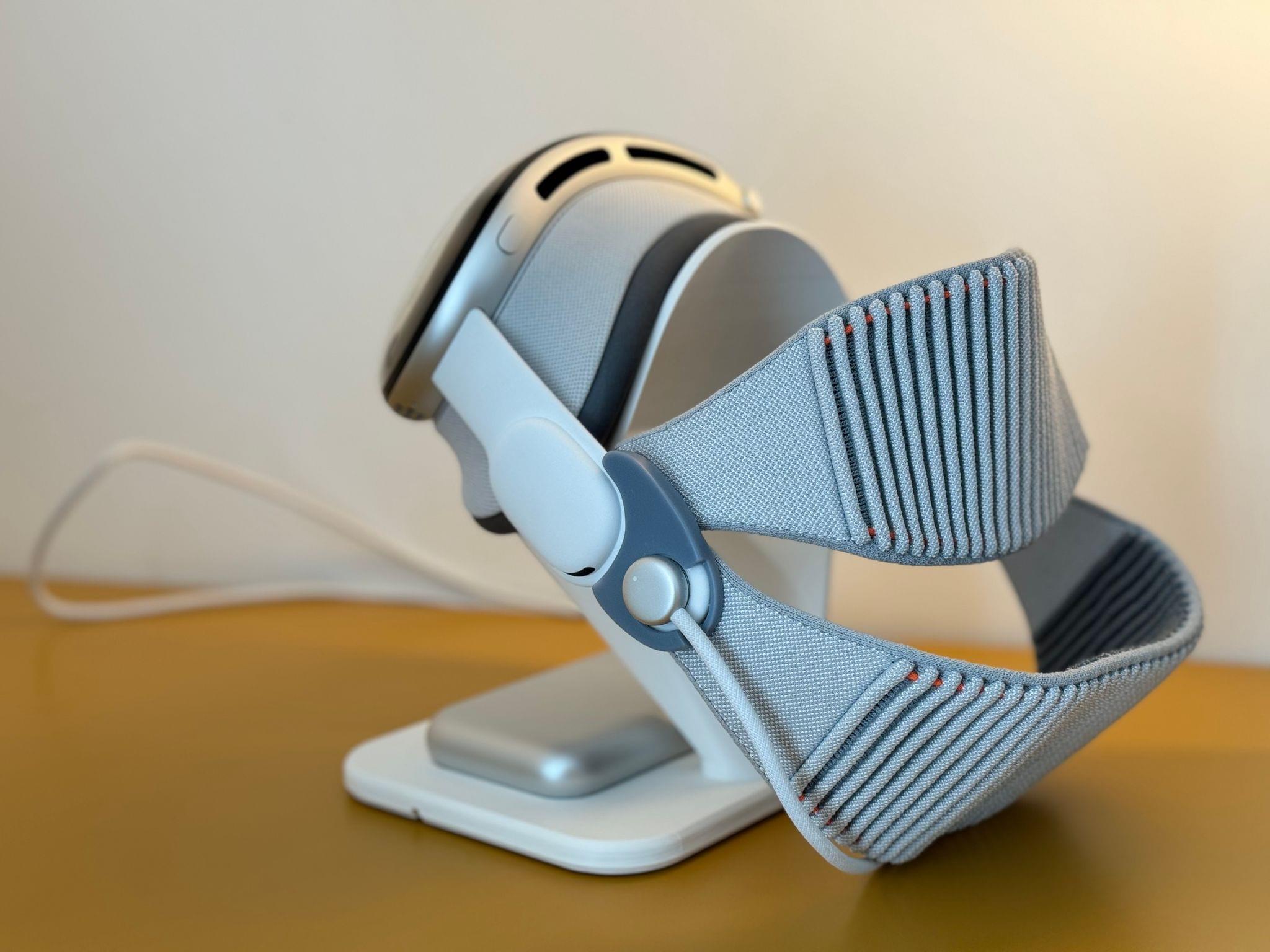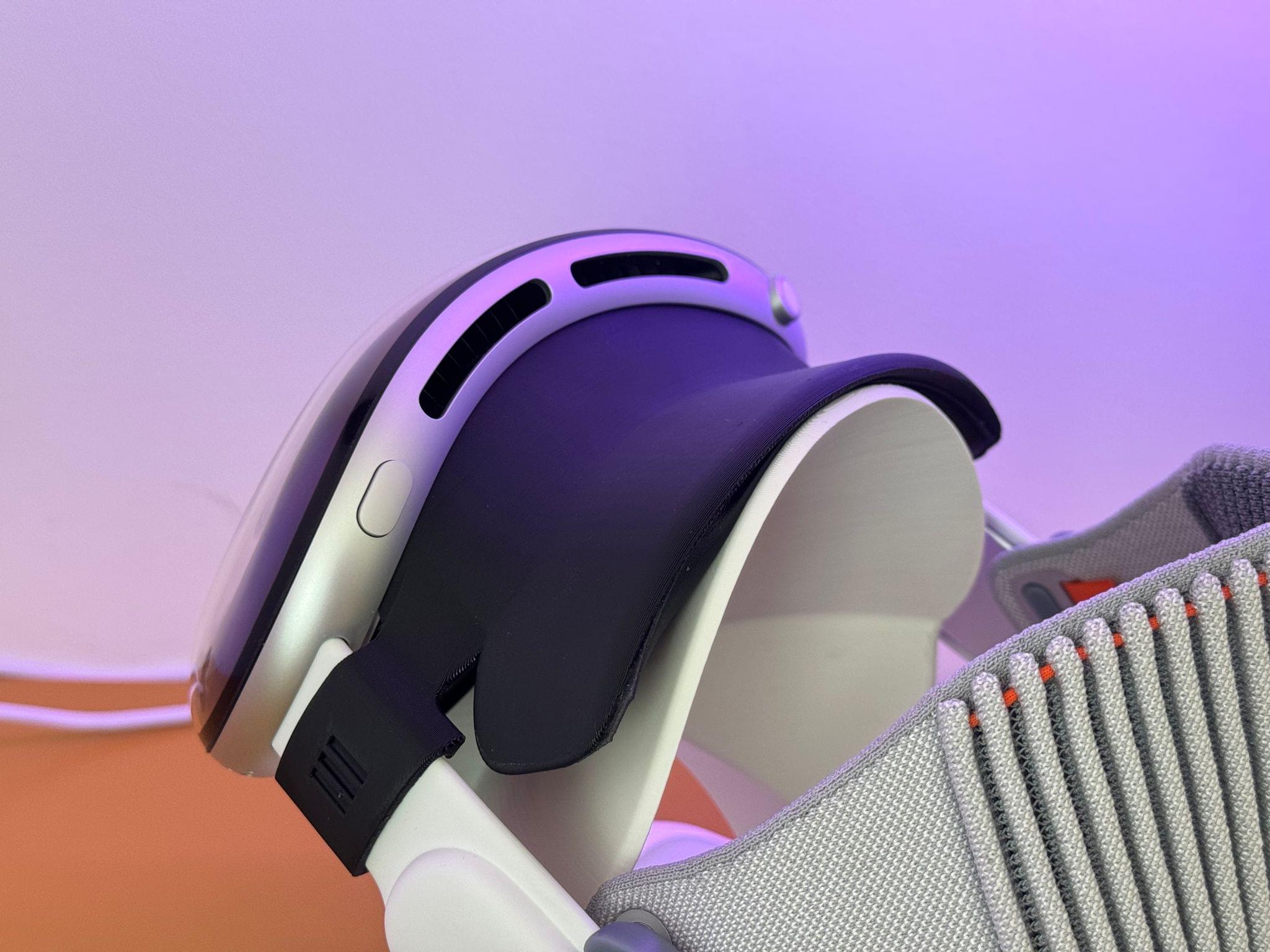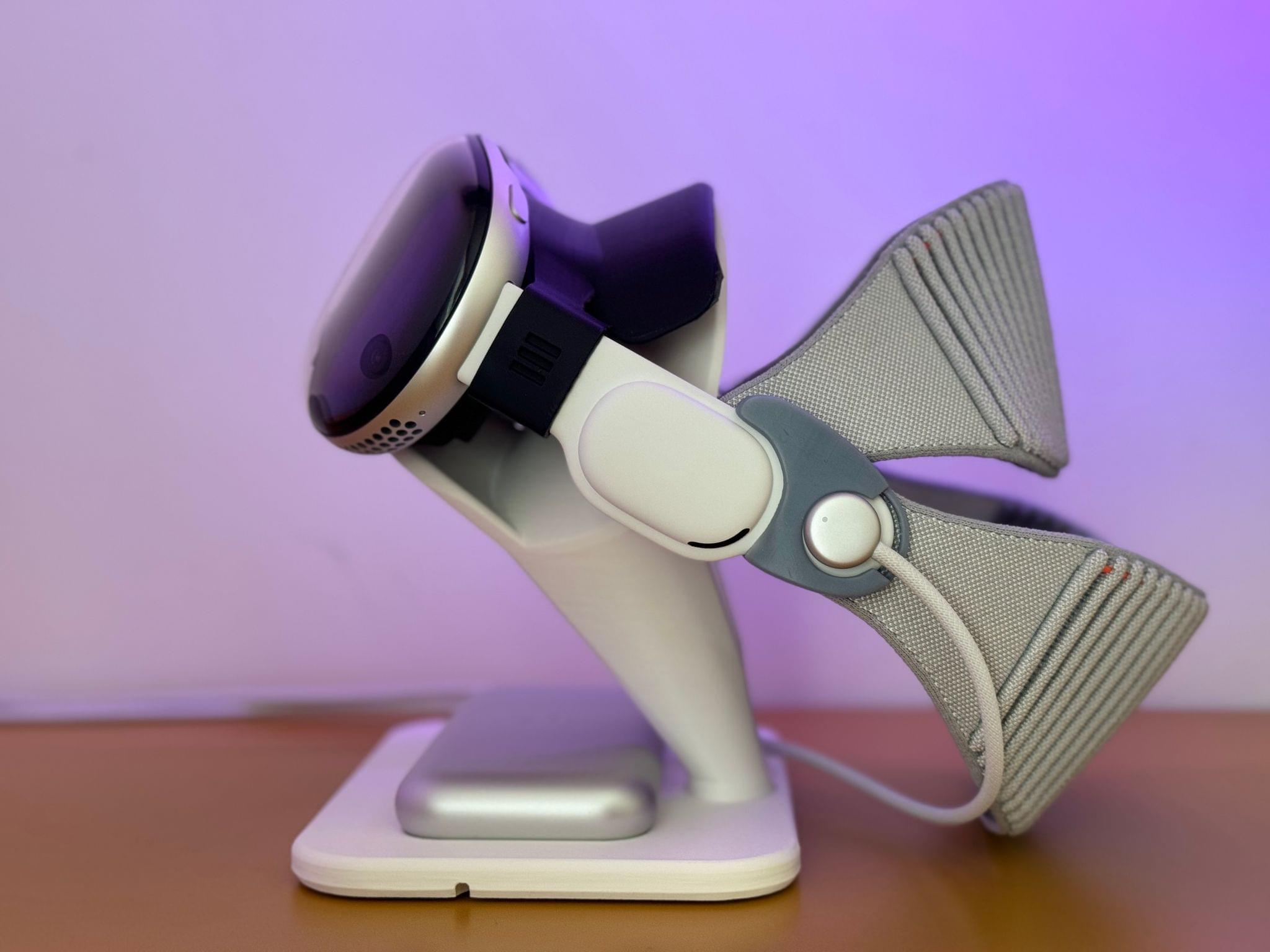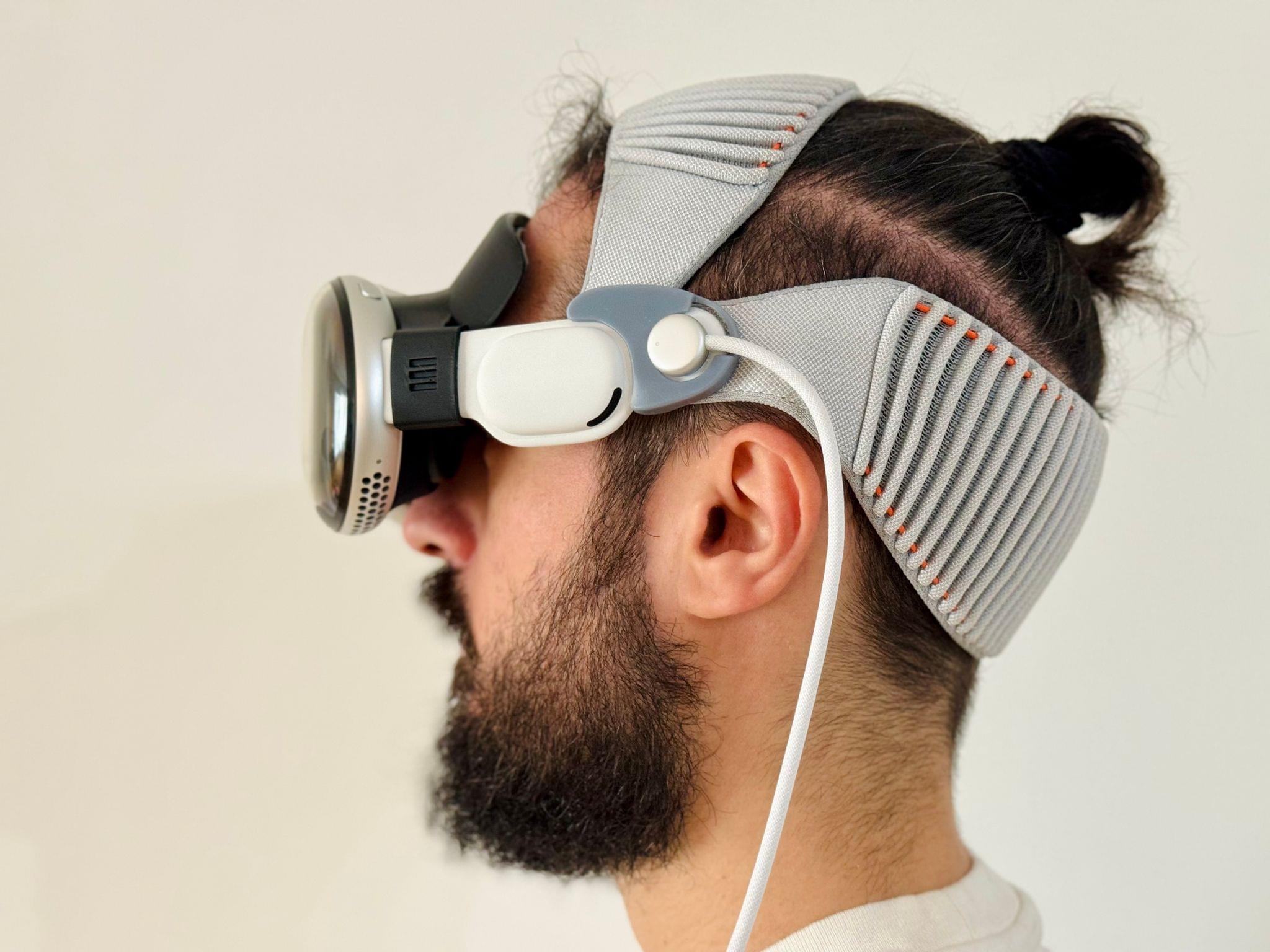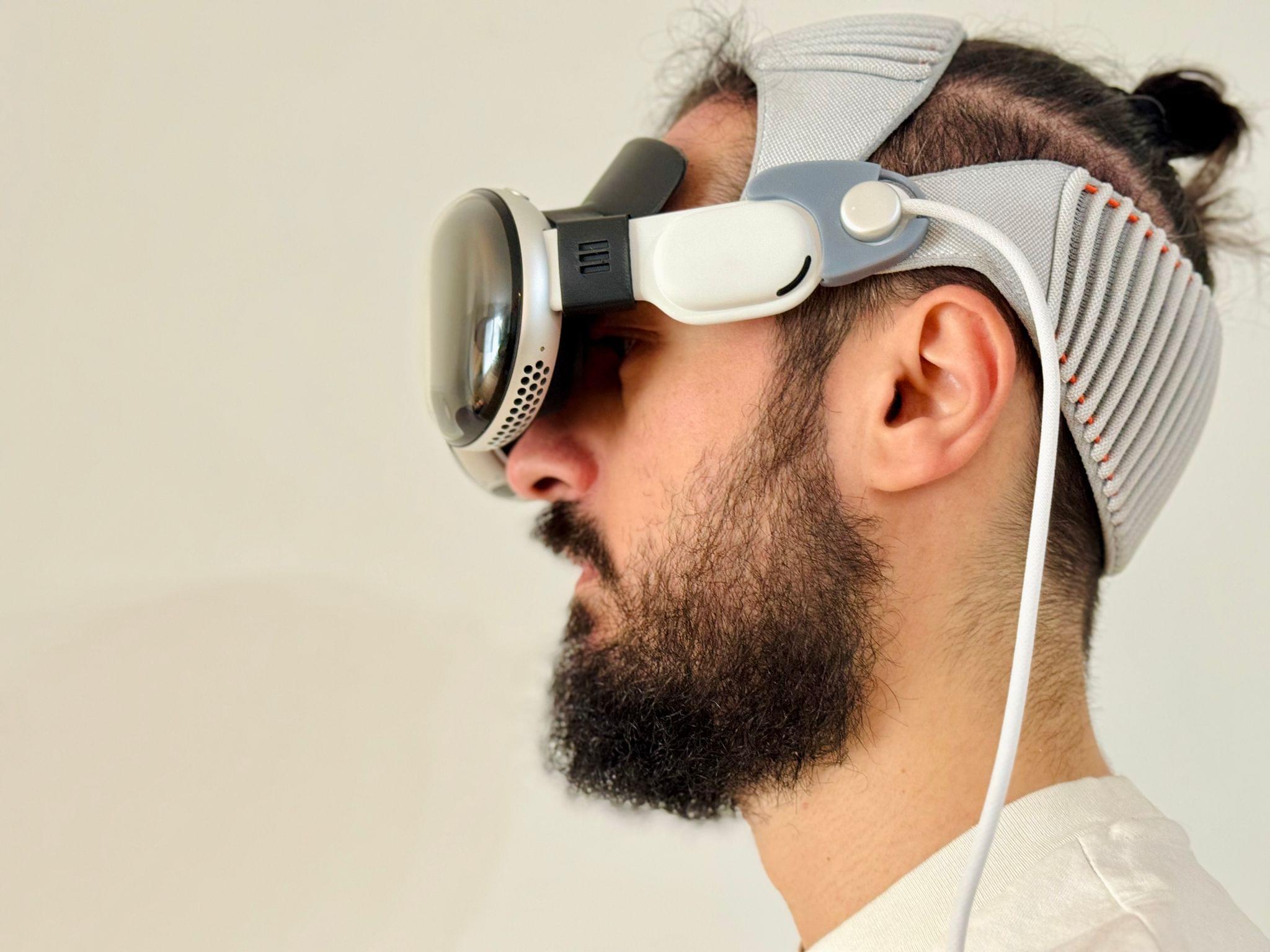 I'm using.](https://cdn.macstories.net/img_0872-1711623741629.jpeg)
My custom Vision Pro setup. This is the stand I’m using.
Vision Pro Chronicles is a MacStories series about our journeys with the Vision Pro. In this series, we’ll explore the potential of visionOS as a brand new platform in our workflows and personal lives, share how we’re using the Vision Pro on a daily basis, and cover interesting apps and accessories for the device.
You’ll be shocked to learn that I’m not using the Vision Pro in any of the default Apple configurations.
After two months spent testing a variety of different options for bands, straps, and other “mounting” solutions, I’ve found my ideal setup. It looks somewhat ridiculous at a glance, and it’s not for everyone, but it allows me to use the Vision Pro for longer sessions.
Most importantly, it helps me enjoy the Vision Pro more.
Let’s back up a little. What you’re reading is the first installment of a brand new series for MacStories and Club MacStories called Vision Pro Chronicles. As the name suggests, we’ll use this column to document our journeys with the Vision Pro. We realized a few weeks ago that it’s impossible for us right now to share a definitive opinion about the Vision Pro in a single, all-encompassing story that would also be enjoyable to read. Part of the problem is that it’s hard to condense into one article all our thoughts about a brand new Apple computer and operating system. But there’s also the fact that the visionOS software and landscape of Vision Pro accessories is rapidly changing before our eyes on a weekly basis.
Every day, John and I are coming across an interesting new app we want to start using, or perhaps yet another accessory on Etsy that we want to try out. The early days of a new Apple product are always an exciting opportunity for us; we want to make the most of it by frequently sharing what we’re up to and how the Vision Pro is changing how we work, consume media, and more.
For all these reasons, just like we kickstarted the Vision Pro App Spotlight series after the Vision Pro’s launch to cover the initial wave of visionOS apps, the Vision Pro Chronicles series will give us a way to share, well, everything else we’re doing with the Vision Pro.
That’s the first half of the context necessary to understand this inaugural Vision Pro Chronicles story. The other context you should know is that, soon after receiving my Vision Pro in February, I quickly found myself largely dissatisfied with the default options for wearing it.
Like others, I instantly fell in love with the feel and dial-based mechanism of the Solo Knit Band, but using it for sessions longer than 30 minutes was consistently giving me headaches since my forehead was bearing all the device’s weight and pressure. I then switched to the Dual Loop Band, which alleviated all of my comfort issues, and I kept using it for about a month. By holding the headset in place with a loop system in the back and at the top of my head, the Dual Loop Band allowed me to use the Vision Pro for hours at a time without feeling any pressure on my forehead or cheekbones. However, I fundamentally dislike how you’re supposed to adjust the Dual Loop Band with velcro. The Fit Dial in the Solo Knit Band is infinitely more elegant than the Dual Loop’s mechanism; even without seeing it, you can easily find the dial, turn it, and immediately feel what it’s doing on your head.
The more I thought about it, the more I started accepting a simple fact: just like I’ve done with other Apple computers in my life, I’d have to consider modding the Vision Pro too. What I wanted didn’t exist: a way to use the Vision Pro with a “dual knit band” setup – one in the back, one at the top.1 And I had to figure out how to make that happen.
Enter the beautiful world of the Vision Pro subreddit and Etsy. As I discovered, I wasn’t the only person who’d been looking for ways to use the Vision Pro beyond Apple’s default options. Over the past two months, a whole community of modders and folks with 3D printers have come together to offer a selection of Vision Pro accessories that extend the device’s compatibility with either existing VR accessories or Apple’s own Vision Pro bands. To see what I mean, just go to Etsy, search for “Vision Pro”, and you’ll get the idea. As you can see, there’s a very common category of accessories: third-party clips and mounting systems to use two Solo Knit Bands at the same time.
What I’m going to say next is not an exaggeration: I’ve spent the past month buying literally every single one of these adapters I could find. If you’ve made one of these and released it on Etsy, chances are you’ll find a ‘John Voorhees’ in your purchase history2. At this point in late March 2024, I have tested nearly all the options from Etsy; the two that are missing from my list are currently on their way from the United States to Italy.
In the process of testing these accessories, I’ve also settled on something else: whenever possible, I love using my Vision Pro without a light seal in an “open” configuration that, yes, lets more light in but also makes me more aware of my surroundings with a larger field of view.
So, for this first installment of the Vision Pro Chronicles, let me go over how I like to use the Vision Pro on a daily basis and how you can replicate this setup yourself.
Dual Knit Bands
I’ll cut to the chase and tell you immediately what is, in my opinion, the best Vision Pro accessory to use two Solo Knit Bands at the same time: it’s the SoloTop.
Of all the adapters I’ve tried, the SoloTop was the one with both the best build quality and the best angle for the Solo Knit Band you’re going to place on the top of your head to hold the Vision Pro. You don’t need to try all the other adapters like I did; if you’re looking for this type of product, just get the SoloTop.
Allow me to explain how this works. The idea is that you want to add a second Solo Knit Band to the Vision Pro to relieve pressure from your nose and cheekbones, which is where you’d usually feel the device’s weight when using the standard Solo Knit Band setup. To do this, the Vision Pro needs an extra pair of connectors to attach a second Solo Knit Band, which is what the SoloTop provides.
The SoloTop is comprised of two 3D-printed clips that you need to slide onto each Vision Pro Audio Strap. Once they’re on, the Vision Pro’s built-in strap connectors will remain exposed, and that’s where you can attach the Solo Knit Band that will rest on the back of your head as always. What the SoloTop adds is an additional pair of connectors for the band that goes above your head.
Now, you may be wondering: what makes the SoloTop special compared to other adapters that roughly offer the same functionality? Besides the quality of the printed material (it’s smooth and precisely cut – a major difference from other sloppy clips I got on Etsy), it’s the angle that makes the SoloTop a winner in my book. You see, most adapters for two Solo Knit Bands have connectors for the top one that make it sit perfectly horizontal on top of your head, thus creating a 90-degree angle with the one in the back, like this:
)](https://cdn.macstories.net/il_1588xn-5857616382_eeja-1711624590069.jpg)
The 90-degree layout looks great in pictures, but it’s not for me. (Source)
This looks good in photos, but, in practice, it’s been horrible to use. With the perpendicular layout, the top band ends up covering the part of your head just above the forehead, which, at least for me, was both uncomfortable and silly-looking.
The SoloTop’s creator, on the other hand, rightfully added some inclination to the top connector so that the band is pushed diagonally toward the back of your head, at least a little. This is what you want; with this configuration, there’s enough room between the Vision Pro’s light seal resting on your forehead and the Solo Knit Band at the top, which you can adjust depending on how far you want to lift the headset off your nose and cheekbones.
This is what I look like wearing my Vision Pro with the basic ‘Dual Knit Closed’ setup featuring the SoloTop, two Solo Knit Bands, and the light seal:
I’ve been running this setup for nearly a month now, and I can’t even begin to express a) how comfortable it is and b) how much I prefer adjusting the Solo Knit Bands to the Dual Loop Band. There are some real accessibility benefits to the simplicity of the Solo Knit Band’s Fit Dial that I haven’t found in any other Vision Pro band or strap, from Apple or otherwise.
Thanks to two Solo Knit Bands, I can use the Vision Pro for hours without interruptions or feeling any neck or head strain. The band’s soft material and its large surface area make for a fantastic combo when it comes to balancing weight and removing pressure from my nose. If you can get past the potentially odd look caused by wearing two large bands at the same time, I can’t recommend doing this enough. And, of course, I hope Apple will consider bulkier, but more comfortable, band configurations in the future.
That being said, I have some additional tips and notes to share if you want to replicate this setup.
First, I was asked by a few Club Discord members if using the SoloTop negatively impacted sound quality of the Vision Pro’s Audio Straps in any way, and I’m pleased to report that it doesn’t. The SoloTop doesn’t directly touch the speaker in the Vision Pro’s side straps, so there’s no issue on that front. Also, since I started using the SoloTop, its creator released a ‘Dev’ edition that is compatible with the Developer Strap. I have a Developer Strap, but I don’t use it since its functionality is so limited right now. If you keep your Developer Strap always attached to the Vision Pro, however, you’ll probably want to get this version of the SoloTop instead.
Additionally, I have some recommendations on the Solo Knit Band sizes. Based on my own experience and from what I’ve read in different threads on Reddit, you’ll likely want to get a second Solo Knit Band for the top of your head that is one size smaller than the primary one in the back. I, for instance, wear an M-size Solo Knit Band in the back of my head, but I had to get an S-size one for the top because the larger size was too loose. There’s really no good way to test this in Apple’s retail stores, so perhaps you could get two different sizes and return the one you don’t need.
The ‘Dual Knit’ setup has been a game-changer for my usage of the Vision Pro so far, but it’s only one part of the story.
Air Cover and My ‘Dual Knit Open’ Vision Pro Setup
When I first read that some people were using the Vision Pro without a light seal between the headset’s lenses and their eyes, I thought it sounded too ridiculous to be true. Then I tried it myself, and I became a believer. I’ve been using my Vision Pro without a light seal for the past three weeks, and, for most scenarios in my daily life, I can’t imagine going back to wearing the light seal at all.
Before I get into the details of what I’ve done here, it is necessary to contextualize how I use the Vision Pro and why eschewing the light seal is okay for me.
In the almost two months I’ve had the Vision Pro, I’ve realized that I tend to use it more as an AR/MR device than a VR one, which means that I prefer to be in passthrough mode the majority of the time and very, very rarely immerse myself in VR environments that occlude my surroundings.
There are a few reasons behind this preference. The first one is that I find VR isolating. It’s hard enough to be “accepted” by other people in my house when I’m wearing the Vision Pro (even if they know I can see them); blocking out real life to be immersed in an environment feels like a step too far, socially speaking, when I’m not home alone. However, even when I am by myself, I still have two dogs I want to keep an eye on and, you know, simply see to enjoy their company when I’m working. I’m sorry, Apple, but Zelda and Ginger resting next to me or wanting head scratches will always be superior to Haleakalā and Yosemite.
But there’s something else, too. I like the feeling of turning my house into a futuristic workspace with windows floating all over the place. It looks cool (which makes me feel good about using the Vision Pro), keeps me more aware of my surroundings, and allows me to move around the house while wearing the Vision Pro and looking at apps. For instance, I’ve cooked dinner a bunch of times while wearing the Vision Pro and setting up floating timers on my kitchen stove, and it’s been a transformative experience in its “simplicity”. I love the feeling of turning my physical space into a computer monitor wrapped around me.
Once I realized that, on a daily basis, I like to be in passthrough mode and seldom take advantage of complete immersion, an idea clicked in my brain: if I don’t want to be immersed, do I even need to block out external light? And that’s when I understood that the folks on Reddit I once ridiculed were right all along.
A few weeks ago, I was able to order the Air Cover, a 3D-printed accessory by Infinity One that lets you use the Vision Pro without a light seal. Pardon the pun, but thanks to the Air Cover I’ve seen the light – literally.
The idea is pretty simple: if you remove the light seal from a Vision Pro, your eyes are going to get closer to the lenses, which may generate a larger field of view; you also get better air flow while wearing the headset (there’s no seal blocking out air anymore) as well as real peripheral vision. Now, we all have different physiognomies, and therefore, your mileage may vary. But in my experience, all these promises have turned out to be true thanks to the Air Cover, which is also incredibly comfortable to wear since it transfers weight from my face to the upper part of my forehead. When combined with my Dual Knit setup, I don’t feel the weight of the Vision Pro on my face anymore.
The folks at Infinity One have accounted for potential issues with using a Vision Pro without a light seal and made a series of smart design decisions. The main one: I can use the Air Cover with my ZEISS prescription lenses just fine since there is a cushion (made of foam and faux leather; it’s smooth and comfortable) that sits on my forehead and creates a minimal distance between my eyes and the lenses. In simple terms, when I bat my eyelashes, they don’t brush against the ZEISS lenses. I still occasionally get the “too close to display” alert in visionOS, but I can either ignore it and nothing happens3, or I can turn the dial for the Solo Knit Band in the back to make it a bit looser, and the alert will go away on its own.
As you can see from the photos below, the Air Cover was designed to attach to both the Audio Straps and the headset itself, with the cushion protruding with a curved design that ensures it can rest on your forehead. My only criticism (besides the fact that Infinity One is often out of stock of Air Cover units) is that I wish the accessory came in more colors and a nicer material than the 3D-printed resin it’s currently made of.
Comfort aside, it’s the experience of using visionOS without a light seal that has deeply changed my relationship with the Vision Pro.
The best way I can describe it is that it feels like going from wearing a headset to wearing heavy glasses with very thick frames (and I say this as someone who wears eyeglasses every day). I still get the “tunnel vision” effect that’s typical of the Vision Pro, but it’s less pronounced compared to when I’m using the light seal, and as a result, my field of view is also larger since my eyes are closer to the displays. This is something I’ve especially noticed on the horizontal axis, which is also backed by measurements taken by Infinity One using the ALVR app for visionOS. According to their study, the Air Cover netted a 13% improvement in horizontal FOV and 7% in vertical FOV, which lines up with my experience. It’s not dramatically larger, but it is something I notice.
Even if we disregard the FOV argument, the increased air flow and natural peripheral vision have been fantastic improvements over the vanilla Vision Pro experience.
Without a light seal, there’s more air flowing between my face and the headset, and that feels great. I can wear the Vision Pro for hours without sweating in it, and everything feels cooler. I also don’t get the skin marks from the light seal that made me look like a raccoon before, so that’s also nice. But most importantly, my eyes can see more on the periphery on all sides, which is great for staying more aware of my surroundings, checking my watch or phone, and generally using my hands in the real world despite the headset on my face.
The combination of all these factors has resulted in me using the Vision Pro more because it fits better into my everyday life. Since I tend to favor augmented and mixed reality over virtual reality, and given how I want to turn the Vision Pro into my main computer (effectively replacing the iPad in my life), being able to work in it for prolonged sessions with maximum comfort and increased awareness of my surroundings has been, quite frankly, astounding.
I can’t imagine going back to the light seal for general computing tasks on the Vision Pro.
With a few accessories, I feel like I’ve been able to turn the Vision Pro into something that it couldn’t be when I first got it. It hasn’t even been two months since the device launched, and I’ve already seen some wild ideas from the modding community and accessory makers. Being along for this ride, especially once the Vision Pro launches in more countries, is going to be fun.
- In their original marketing video, Apple showed a still-unreleased Solo Knit Band with an additional strap at the top to relieve pressure from your face. Not exactly what I wanted, but close enough. ↩︎
- I need to acknowledge and thank John for putting up with me and shipping all this stuff from the United States. ↩︎
- Optic ID works just fine. ↩︎


